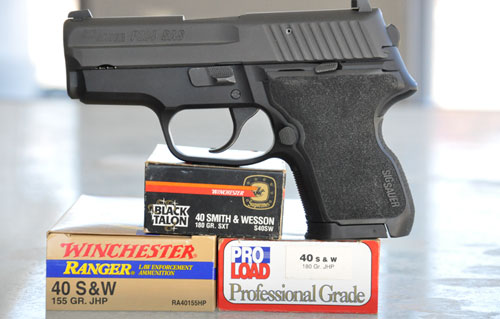
We called it the Pocket Rocket. When stoked with hot Border Patrol issue .40 S&W ammunition, the little Glock 27 sub-compact was a handful. It roared and spit and bucked, but with practice I managed to tame the little pistol and it became my concealed carry pistol of choice for many years. When it was introduced, the G27 was in a class by itself. Today, we’re fortunate to have many more choices in compact .40 S&W pistols, not the least of which are the ones made by Sig Sauer of Exeter, New Hampshire.
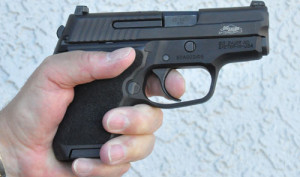
Anyone familiar with the Sig 226 or Sig 229 lines of pistols will find the compact Sig 224 comforting, as the manual of arms is exactly the same. In fact, the 224 is simply an abbreviated version of the full size Sig 229 and would make an excellent back-up, plain clothes or off duty piece for those who carry a Sig 229 as a working pistol, or perhaps, for those who have a full size 229 as a house or office pistol and wish to have the “same” gun in a smaller package for discreet carry. Although the smaller 10 round Sig 224 magazines are too short to use in the bigger Sig 229, it’s not a problem to use the longer 12 round capacity magazines in the little pistol. Carrying this one step further, if you wanted both pistols to have the same trigger system, the 224 has the DAK system and there is a 229 model with the DAK trigger as well.
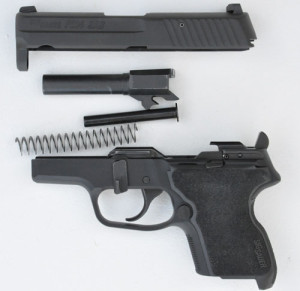 This begs the question: What is a DAK trigger? Glad you asked, and we’ll keep it simple (I’m no engineer). DAK means Double Action Kellerman, in other words, a double action trigger named after the clever fellow who designed it, one Mr. Kellerman. Offering a smooth, 10 pound double action trigger, the DAK system does a couple of other things. When the slide cycles and cocks it, the external hammer is held away from the firing pin and this, along with the firing pin safety, keeps the pistol from firing if dropped. And, similar to Sig’s Short Reset Trigger (SRT), the DAK trigger moves forward with two distinct “clicks”, the first offering something of a short reset. Another question: What does SAS mean? No, it’s not Special Air Service, although that would be a cool name, it simply means the pistol is “anti-snag” and has had all the sharp edges rounded off to make it more suitable for concealed carry.
This begs the question: What is a DAK trigger? Glad you asked, and we’ll keep it simple (I’m no engineer). DAK means Double Action Kellerman, in other words, a double action trigger named after the clever fellow who designed it, one Mr. Kellerman. Offering a smooth, 10 pound double action trigger, the DAK system does a couple of other things. When the slide cycles and cocks it, the external hammer is held away from the firing pin and this, along with the firing pin safety, keeps the pistol from firing if dropped. And, similar to Sig’s Short Reset Trigger (SRT), the DAK trigger moves forward with two distinct “clicks”, the first offering something of a short reset. Another question: What does SAS mean? No, it’s not Special Air Service, although that would be a cool name, it simply means the pistol is “anti-snag” and has had all the sharp edges rounded off to make it more suitable for concealed carry.
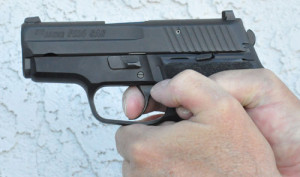
The 224 SAS is a chunky little pistol. It feels substantial, heavy and a little blocky at first. Weighing 28.0 ounces with an unloaded magazine, the pistol is 7 ounces heavier than my Glock 27 and sits a little higher in the hand. The steel slide, alloy frame and pebbled wrap around plastic grips are snag free as advertised; I couldn’t find a sharp edge on the pistol. The rear of the trigger guard is cut high into the frame (a modification I make with a rotary tool on all my Glocks) and the front of the grip is checkered at about 20 lines per inch and provides a secure grip without being sharp. The pebble pattern on the grips are, well, grippy, and provide a secure hold. Overall, it’s apparent all the parts of the Sig 224 SAS are designed to contribute to a controllable pistol.
At the Range
Getting right to the heart of the matter, I decided to test the Sig 224 with premium defensive ammo to see how controllable it was. That presented something of a problem, as .40S&W defensive ammunition is, like a lot of ammo these days, unobtainable. The solution was to dig into my stash, where I selected three rounds that should be representative of current defensive ammunition offerings. Despite having a short, 3.5 inch barrel, the first surprise of the day occurred when the 224 produced velocities meeting or exceeding the standards for these loads in a full size service pistol. For example:
- Winchester 180 grain Black Talon, average velocity 963 feet per second.
- Pro Load 180 grain Jacketed Hollow Point, average velocity 958 feet per second.
- Winchester Ranger 155 grain Jacketed Hollow Point, average velocity 1212 feet per second.
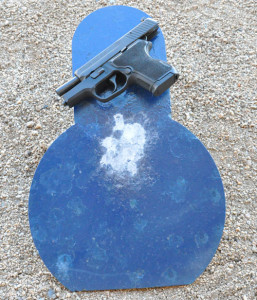
Black Talon ammunition, as you may remember, was rebranded as SXT Ranger by Winchester after the bed-wetters became alarmed over the name and fussed about it. The Winchester Ranger 155 grain load is one of the duty loads used by the Border Patrol and it’s advertised as running 1195 feet per second. The Pro Load is supposed to run about 950 feet per second in pistols with longer barrels.
The second surprise of the day occurred when I started shooting the 224 with these hot loads. To my considerable surprise, the little pistol was very pleasant to shoot and I experienced none of the shock and awe I have come to associate with hot .40S&W ammunition in little pistols. Even the hotter Border Patrol ammunition was completely controllable, easy to shoot, and I could have shot it all day. The three dot Siglite night sights were dead on, provided a perfect sight picture and I never missed a shot at 25 yards on a 10 inch steel plate. The DAK trigger is easy to manage, and, although this was unexpected as well, I prefer it to the SRT trigger on the Sig 226 I tested last year. Throughout a morning of shooting, the little pistol ran without a single malfunction, reinforcing my opinion that Sig pistols are as reliable as anyone could expect.
Clearly, the slight extra weight and the ergonomic design of the Sig 224 SAS contribute to its shoot-ability. This is a great little pistol on its own merits, and the perfect companion or back-up pistol to the Sig 229.
For more information, visit www.sigsauer.com.
About the Author:
 Ed Head is a regular on Shooting Gallery and Down Range TV. He has worked for almost 30 years in law enforcement, first in the United States Air Force and then with the United States Border Patrol, retiring as a Field Operations Supervisor. During his Border Patrol career, Ed worked in a variety of patrol, investigative and training capacities. Ed has an extensive background as a firearms instructor, having trained thousands, ranging from beginners to police, military and special operations personnel. Having taught at Gunsite for 20 years, Ed first trained there under the world famous shooting school’s founder, Jeff Cooper, then later ran the school as the operations manager for more than five years. Ed lives in Chino Valley, Arizona, where he continues to teach and write.
Ed Head is a regular on Shooting Gallery and Down Range TV. He has worked for almost 30 years in law enforcement, first in the United States Air Force and then with the United States Border Patrol, retiring as a Field Operations Supervisor. During his Border Patrol career, Ed worked in a variety of patrol, investigative and training capacities. Ed has an extensive background as a firearms instructor, having trained thousands, ranging from beginners to police, military and special operations personnel. Having taught at Gunsite for 20 years, Ed first trained there under the world famous shooting school’s founder, Jeff Cooper, then later ran the school as the operations manager for more than five years. Ed lives in Chino Valley, Arizona, where he continues to teach and write.

It’s a great pistol, just a shame Sig had to screw it up by redesigning their mags so none of the older mags work in the P224.
I got a chance to ask a Rep at SHOT what was Sig thinking in redesigning the magazine and mag well, he told me, “It’s to save weight.” That sounds like a bs response, but whatever, just means I’ve got to stick with the classic Sigs.